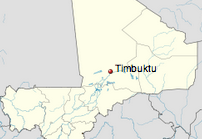For the past several months, Northern Mali has been under the control of a patchwork of rebel groups. One group, a Tuareg tribal militia known as MLNA were armed by Gaddafi and fought on his side during Libya’s civil war. When Gaddafi fell, the MLNA turned its sites (and guns) on creating a homeland for their ethnic group in Northern Mali. To bolster their cause, the Tuaregs (who are more ethnic nationalist than religious zealots) formed an alliance with some other militias in Northern Mali, including two that are hard line Islamist.
One of these groups is called Ansar Dine, which proudly boasts an affiliation with Al Qaeda. (Think: Taliban of the Sahel.) This group is currently in control of the town of Timbuktu, a city that once was the cultural and intellectual heart of west Africa.
Great mosques and mausoleums to local saints of unique architectural design were erected in the 15ht and 16th century, and the city is home to a long tradition of a local Sufism, which is an Islamic mystic tradition. The Ansar Dine group draws inspiration from an entirely different tradition of Islamic puritanism known as Salafaism. Salafists believe that any innovation from the original version of Islam as practiced in the Arabian peninsula in the time of Mohammad is blasphemy.
You can probably see where this is going: Now that Ansar Dine has firm control over Timbuktu, they’ve started to purge the city of its religious relics and destroy historic cultural sites deemed blasphemous. This campaign bears strong hallmarks of the Taliban’s 2001 destruction of the Buddha’s of Bamiyan.
Bamiyan Buddha’s Before and After Taliban destruction
Humanity may be very close to once again losing a part of our common cultural heritage because of the violent, intolerant impulses of a heavily armed group. Several Timbuktu religious sites have already been reported destroyed in whole or part. From UNESCO Director General Irina Bokova:
“Reports that the Mausoleums of Sidi Mahmoud, Sidi Moctar and Alpha Moya have been destroyed is extremely distressing,” the Director-General said. “There is no justification for such wanton destruction and I call on all parties engaged in the conflict to stop these terrible and irreversible acts, to exercise their responsibility and protect this invaluable cultural heritage for future generations.
Here’s a picture of the tomb of Mahmoud Sidi, before it was destroyed.
Here’s another mausoleum under threat.
The spiritual and economic lifeblood of a city is poised to be reduced to rubble. This is a very dark day for humanity.
Timbuktu photo 1: Martha de Jong-Lantink, via Global Heritage Foundation
Timbuktu photo 2: UNESCO/Eloundou Assomo, Lazare



